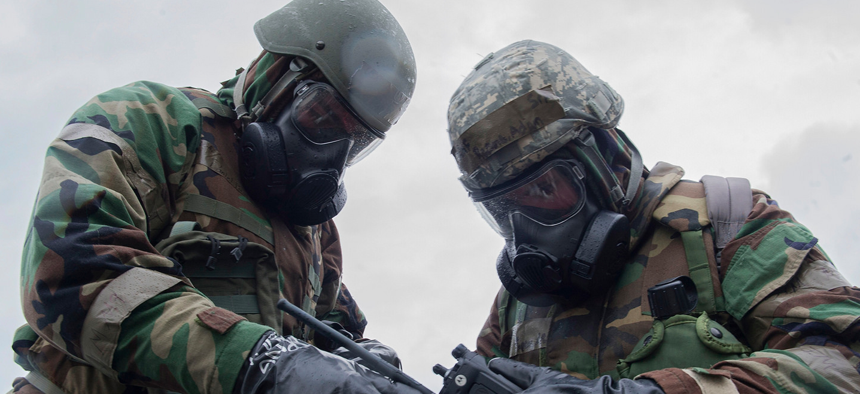
KADENA AIR BASE, Japan (Feb. 9, 2017) - U.S. Air Force Senior Airman Adam Reams and Airman 1st Class Daniel Paolucci, 18th Communications Squadron client systems technicians, conduct a post-attack reconnaissance stand check during Exercise Green Dragon at U.S. Air Force photo by Senior Airman Lynette M. Rolen
It’s Getting Too Easy to Create Dangerous Viruses
The upcoming national biodefense strategy should ensure that scientific journals don’t help terrorists learn how.
The news that researchers have recreated an extinct cousin to the smallpox virus using only commercially available technology and items purchased over the Internet renews concerns that bioterrorists could do the same if detailed information about the methods were published. Here’s the problem: scientific journals are geared toward publication, often without sufficient understanding of the public-security risks. We need a better system to ensure that information that could help bad actors stays unpublished.
It took David Evans’ team of scientists at the University of Alberta in Edmonton, Canada, about six months and $100,000 to recreate the horsepox virus, a close relative of the smallpox virus that killed perhaps 300 million people in the 20th century before it was eradicated in 1980. In a summary of the research, the World Health Advisory Committee on Variola Virus Research wrote that “recreation of such viral genomes did not require exceptional biochemical knowledge or skills, significant funds, or significant time.”
Policymakers and bioweapons experts have been worrying about the decreasing cost, time, and skills required for complex synthetic biology ever since Australian scientists accidently created a potentially lethal form of mousepox in 2001. In 2004, the U.S. National Research Council’s prescient report, Biotechnology Research in an Age of Terrorism, forecast the use of molecular biology and genetic engineering to create better biological weapons:
Among the many implications of the anticipated progress in biotechnology is the presumption that it may be feasible to create novel biological agents that are far more predictable and dangerous than any of the naturally occurring pathogens that have been developed as biological weapons in the past…application of new genetic technologies makes the creation of ‘designer diseases’ and pathogens with increased military utility more likely.
Not everyone shares this assessment, as then-Secretary of State Hillary Clinton noted in her 2011 address to the Biological Weapons Convention. Many believe the US focus on bioterrorism obscures the more immediate global need for better monitoring of and responses to naturally emerging pathogens. As Dr. Anthony Fauci, director of the National Institute of Allergy and Infectious Diseases, told the Washington Post, “The danger of naturally evolving microbes, like Zika, like Ebola, that naturally evolve, are much more of a threat to civilization than the possibility that someone might be able to synthesize a microbe.”
This global lack of consensus has led to an international patchwork of regulations with widely varying interpretations of the safety and security aspects of biotechnological research. Potentially pathogenic dual-use research is being conducted in public and private labs around the world with no unifying standards of review, oversight, safety, or security. For example, Evans’s research was approved by the appropriate Canadian regulatory authorities, and would likely have been approved in the U.S. as well, because horsepox is not a threat to humans. But some of the European Union member states might have barred it.
In the absence of global agreement on regulation of risky biotechnological research, much of the security burden has fallen to the editors of scientific journals. This approach has proved problematic, as shown by the U.S. National Science Advisory Board for Biosecurity’s clumsy and highly controversial attempt in 2011 and 2012 to censor two publicly funded avian influenza research studies over security concerns. While publication of Evans’s research has currently been rejected by two leading scientific journals, the NSABB experience tells us that his research will most likely be published at some point.
A thoughtful discussion about the scientific/security tradeoffs of potentially dangerous biotechnological research should not be the sole responsibility of journal editors. In one of its final policy recommendations, the Obama Administration’s White House Office of Science and Technology Policy released agency guidance on voluntary review mechanisms for high-risk biotechnological research with dual-use potential. But Evans’s privately funded experiments also demonstrate the need for a more expansive international framework that works in concert with a non-voluntary system of federal security controls.
Such controls should be part of the comprehensive bioterrorism strategy that administration officials say is coming. Thomas Bossert, the White House Assistant to the President for Homeland Security and Counterterrorism, said last week that the Trump administration is developing a comprehensive plan to defend the nation against bioterrorism. “We have not had, as a country, a comprehensive biodefense strategy ever,” Bossert said at the annual 2017 Aspen Security Forum. “It’s high time we had a biodefense strategy.”
Bossert added that the need for a biodefense strategy has taken on a new urgency because of rapidly advancing biotechnology that allows for the creation of potentially dangerous synthetic viruses. Alluding to the news about the synthetic horsepox virus, the White House advisor noted that scientists might now be able to create a synthetic smallpox without access to the two known live samples. That possibility, he said, “scares me to death.”
Scientific research and its handmaiden, the peer-reviewed scientific journal industry, are by definition open global enterprises, and thus difficult to regulate and control. But this doesn’t absolve the U.S. of its responsibility to develop a comprehensive national biodefense strategy. Such a strategy would also provide a visible demonstration of leadership with the international community. An important first step towards the larger goal of developing an international framework that balances the need for global biosecurity with the equally important need to continually advance scientific discovery – even risky biotechnological discovery.
NEXT STORY: Turkey’s Potemkin Defense Industry